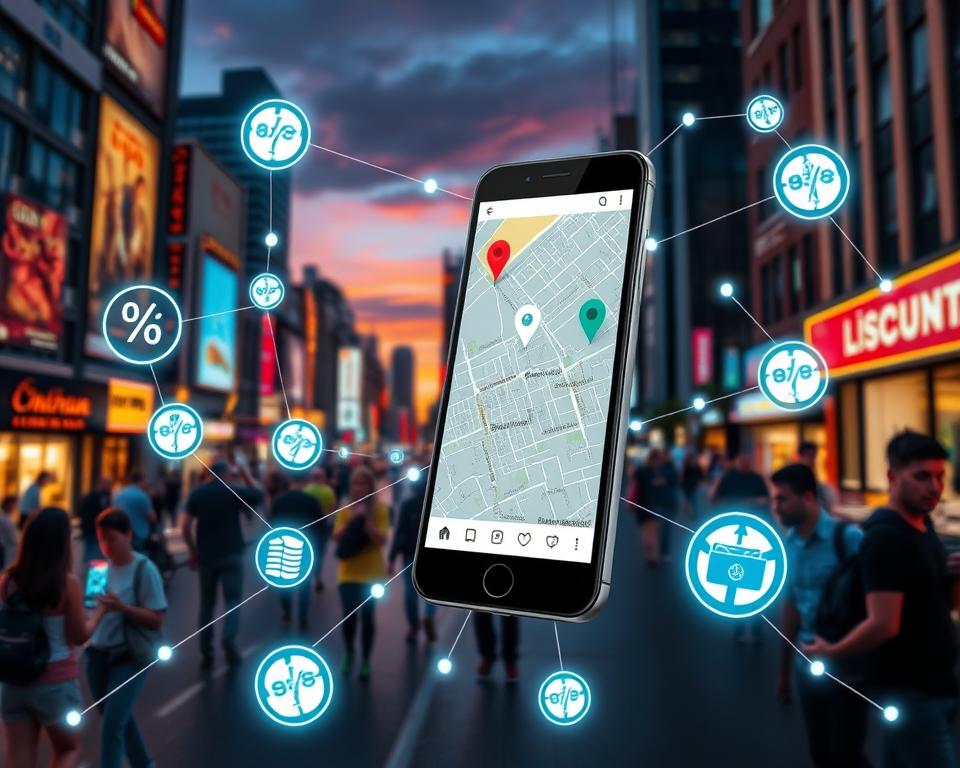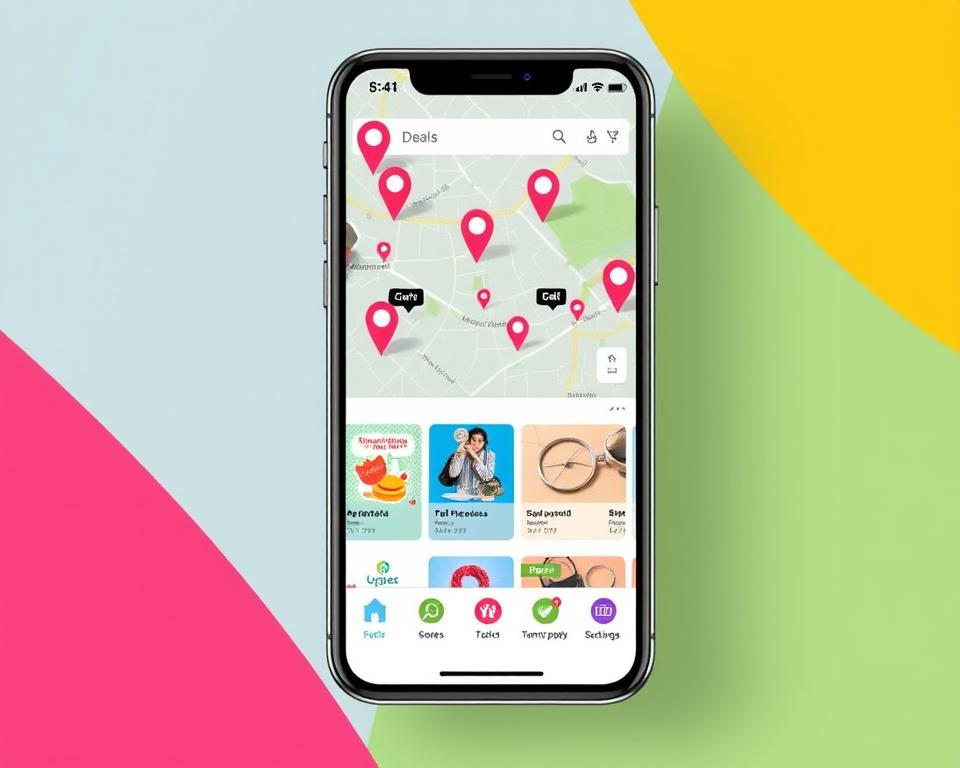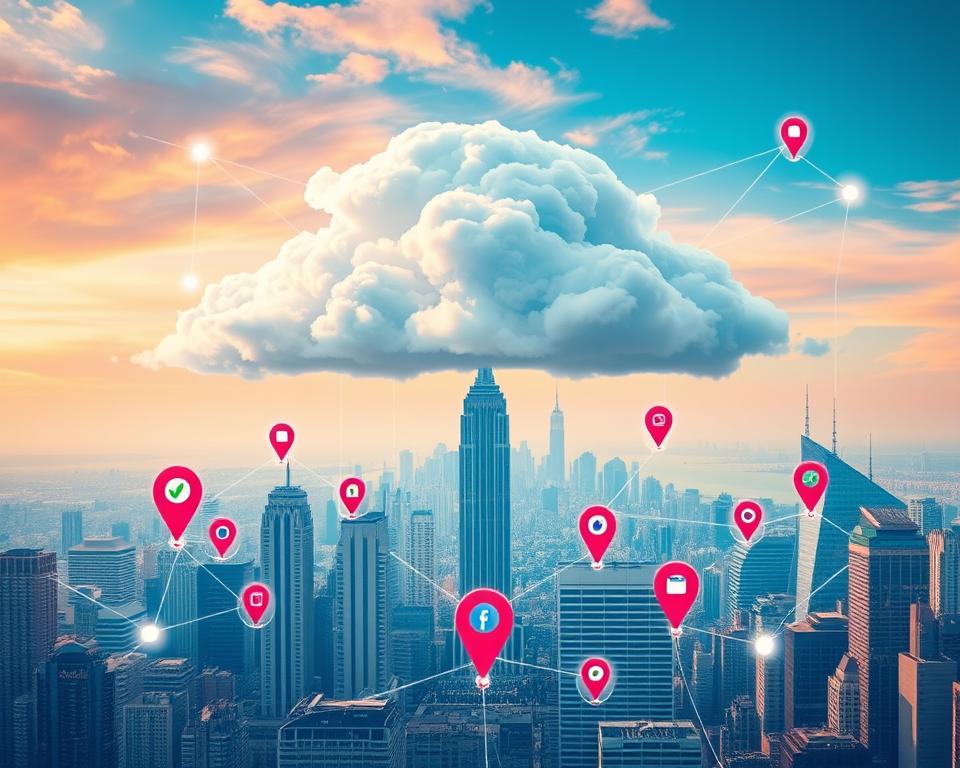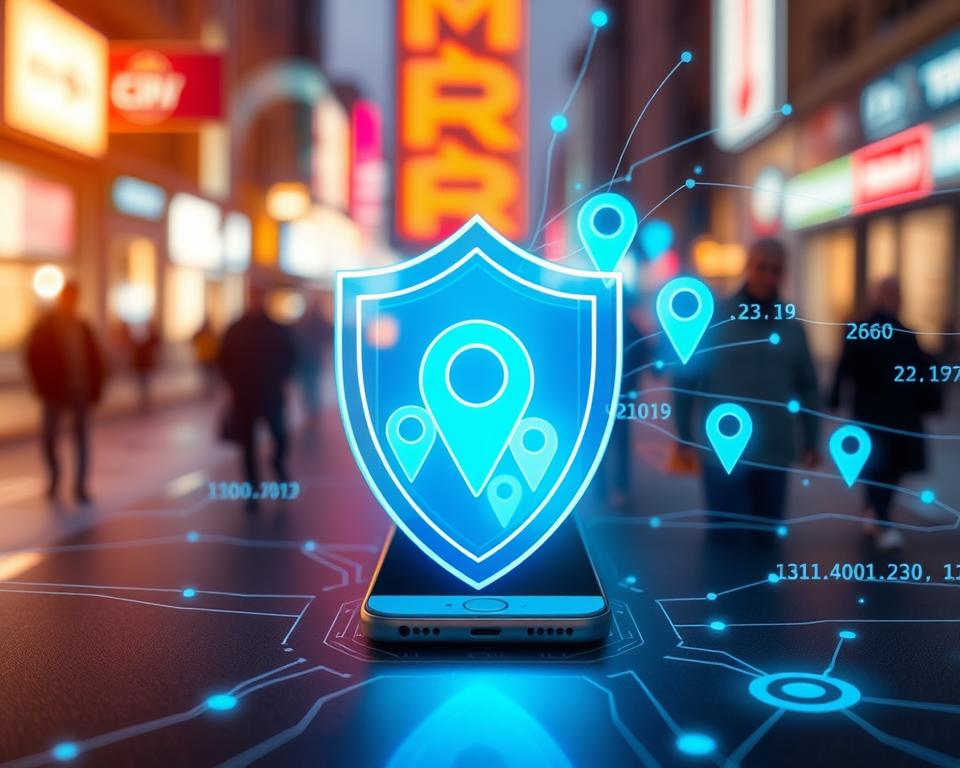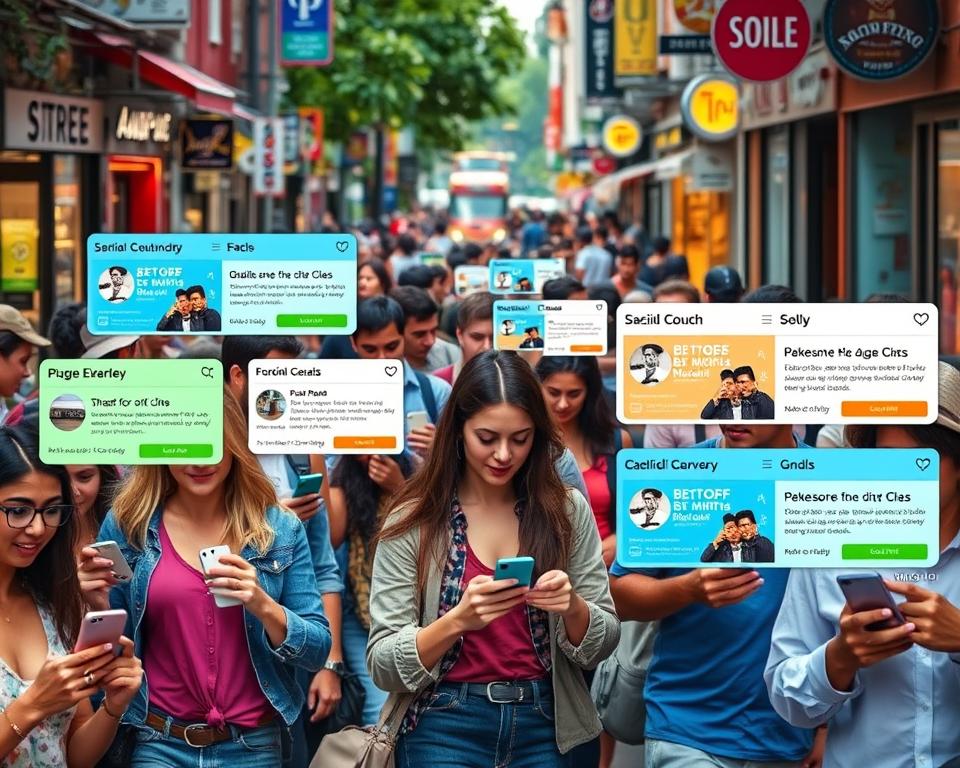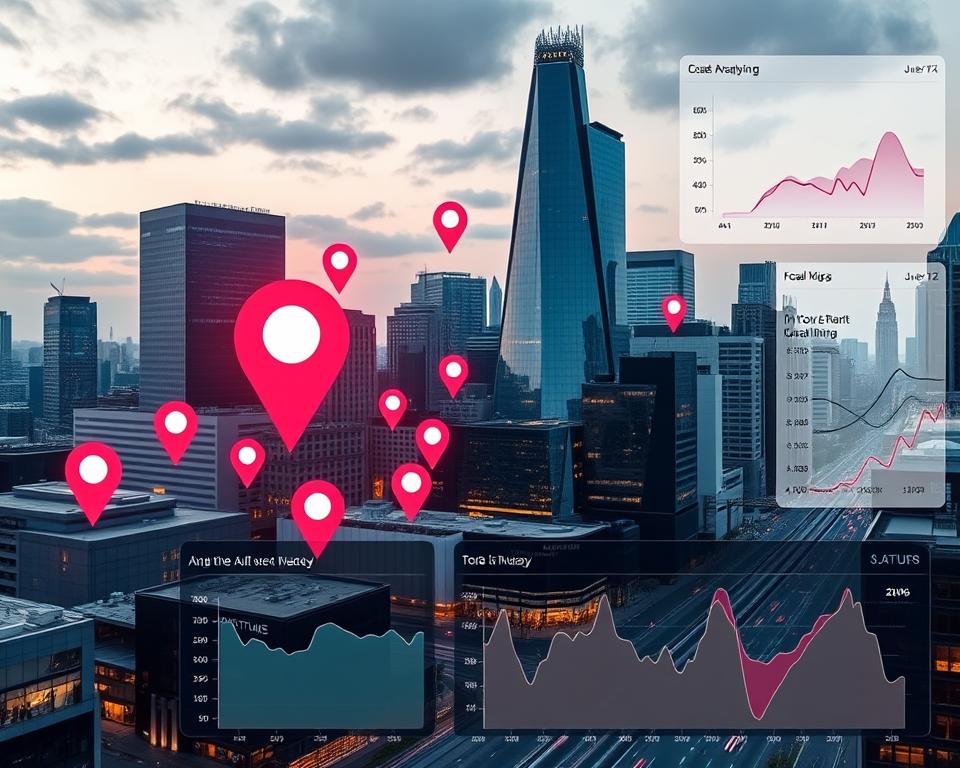In today’s world, mobile apps are key for delivering services based on where you are. They help find the nearest coffee shop or special local deals. This guide will show you how to make mobile apps that use location to connect businesses with customers.
Table of Contents
Key Takeaways
- Explore the core components of location-based technology and its evolving role in modern mobile applications
- Understand the essential technologies and development strategies for building location-aware mobile apps
- Discover effective techniques for integrating GPS and geofencing functionalities to enhance user experiences
- Learn about user interface design principles and backend infrastructure requirements for location-based service apps
- Explore strategies for ensuring data privacy and security in location-based mobile applications
Understanding Location-Based Services in Modern Mobile Applications
In today’s world, location-based services (LBS) are key in mobile apps. They change how we interact with our surroundings. At the heart are GPS and geofencing, which track user locations and offer personalized experiences.
Core Components of Location-Based Technology
GPS is the core of LBS, pinpointing a user’s location. Geofencing uses this data to set virtual boundaries. This lets businesses send targeted ads and offers.
Benefits for Businesses and Consumers
- Businesses get insights into consumer behavior. They can offer personalized proximity marketing and services.
- Users get easy access to local info, deals, and services. This makes shopping and exploring better.
Evolution of Location Services in Mobile Apps
The growth of location services in mobile apps is amazing. From simple maps to advanced location intelligence, the change is fast. Now, apps give real-time traffic, personalized GPS tips, and even AR experiences.
| Technology | Description | Applications |
|---|---|---|
| GPS | Global Positioning System for precise location tracking | Navigation, mapping, location-based services |
| Geofencing | Virtual boundaries around physical locations | Proximity marketing, location-aware services, targeted offers |
The need for personalized, location-based experiences is growing. This will shape the future of digital engagement and customer interactions.
Essential Technologies for Location-Based App Development
The success of location-based apps relies on cutting-edge tech for precise tracking and services. From GPS to Wi-Fi positioning, cellular triangulation, and Bluetooth beacons, these tools work together for a better user experience.
GPS is key for location-based services. It uses satellite signals for accurate location tracking, crucial for outdoor use.
In places without GPS, like indoors, apps use Wi-Fi positioning and cellular triangulation. Wi-Fi uses nearby wireless signals to guess a user’s location. Cellular triangulation uses tower signals for pinpointing.
Bluetooth beacons are also important. These small devices send out signals for precise indoor tracking and services.
| Technology | Description | Advantages |
|---|---|---|
| GPS | Global Positioning System | Accurate outdoor positioning, wide availability |
| Wi-Fi Positioning | Location estimation using wireless access points | Effective for indoor environments, low cost |
| Cellular Triangulation | Location determination using cellular tower signals | Wide coverage, effective for outdoor and indoor environments |
| Bluetooth Beacons | Proximity-based indoor location tracking | Precise indoor positioning, low power consumption |
By using these technologies together, developers can make apps that meet many user needs. This includes outdoor navigation and indoor services.
“The integration of advanced location-based technologies is the cornerstone of modern, context-aware mobile applications.”
Mobile app development for location-based services like local deals and offers
Creating mobile apps for local deals and offers is a complex task. It involves several phases and technical needs. The goal is to make the app easy to use and fun for users.
Key Development Phases
- Defining the app architecture: A strong app architecture is key. It must handle location services, user actions, and backend systems well.
- Implementing cross-platform compatibility: The app must work on both iOS and Android. This is done through cross-platform development.
- Integrating location-based features: Features like geofencing and GPS are added. They make offers more personal and relevant.
- Designing intuitive user interfaces: The app’s look and feel are crucial. It should be easy to use and find deals.
- Developing robust backend infrastructure: A strong backend is needed. It manages data, user info, and updates offers in real-time.
Technical Requirements
Building location-based apps requires certain skills. These include:
- Knowing about app architecture and SDK integration for location services
- Being good at API development for data connections
- Understanding cross-platform development for a unified user experience
- Strong data management and security to protect user info
- Thorough testing to ensure app accuracy and performance
Implementation Strategies
Implementing location-based apps needs a strategic plan. This includes:
- Using location APIs and SDKs to access user data
- Creating user-friendly experiences for finding deals
- Using algorithms for personalized content
- Keeping user data safe and private
- Monitoring app performance and user feedback to improve
By focusing on development phases, technical needs, and strategies, businesses can make great location-based apps. These apps offer real value to users and local businesses.
GPS Integration and Geofencing Implementation
In mobile app development, using GPS and geofencing is key for location-based services. These features help with location tracking, setting virtual boundaries, and sending real-time notifications based on location-based triggers.
Accurate location tracking is the base for these services. By using GPS in mobile devices, developers can find user locations with great precision. This ensures local deals and offers reach the right people at the right time. Location data also helps create virtual boundaries, or geofences, around places like malls or businesses.
When a user goes into or out of a geofence, the app sends real-time notifications about deals nearby. This lets businesses connect with customers better, offering personalized content that boosts sales and user experience.
| Feature | Benefit |
|---|---|
| Accurate location tracking | Ensures local deals and offers are delivered to the right users |
| Virtual geofencing | Enables targeted notifications based on user location |
| Real-time notifications | Provides timely, relevant information to engage customers |
By combining GPS and geofencing, mobile app developers make services that add great value. This approach helps businesses reach their audience better and gives users a personalized experience with location-based deals.
User Interface Design for Location-Based Service Apps
Creating a user-friendly interface is key for location-based apps. It affects how users feel and how much they use the app. By using good design practices, developers can make apps that work well with location features. This makes the app more useful for both businesses and users.
Navigation Patterns
Navigation in location-based apps should be easy and clear. Using common UI patterns like hamburger menus and bottom bars helps users find what they need fast. Also, location-aware interfaces that change based on where you are make the app better.
Visual Hierarchy
A clear visual order is important for showing users what’s important. By placing map integration and offers in the right spots, designers can make the app easy to use. Using the right colors, fonts, and icons helps make the app look good and work well.
Interactive Elements
Interactive parts of the app make it more fun and useful. Features like notifications and interactive maps help users find deals nearby. By designing these elements well, developers can make an app that keeps users coming back.
Backend Infrastructure and Data Management
Creating a successful location-based service app needs a strong backend. This part must handle lots of user data smoothly. Cloud computing solutions are key here. They bring scalability, reliability, and cost savings to meet app needs.
Database management is vital for storing and getting location data from users. NoSQL databases like MongoDB or Cassandra are great. They offer flexibility and scalability for real-time data, ensuring fast access and processing.
Handling scalability in location-based apps is a big challenge. Developers use smart data processing strategies. This includes data partitioning, caching, and parallel processing. These methods help the app handle more users and data without slowing down.
“The backbone of any location-based service app is its ability to process and respond to user data in near real-time. Investing in a robust backend infrastructure is crucial for delivering a seamless user experience.”
Developers design the backend architecture with care. They use advanced database management practices. This way, they make apps that are strong, scalable, and give valuable insights to everyone.
Security Measures for Location Data Protection
In today’s world, keeping location data safe is very important. With more people using apps that track their location, it’s key to have strong security. This protects their data privacy and follows rules like the GDPR.
Data Encryption Methods
Using top-notch data encryption is a big step in keeping location data safe. Mobile app makers use strong encryption to keep user location info secret. This way, even if someone tries to get the data, they can’t.
Privacy Compliance Standards
Following privacy compliance standards, like the GDPR, is a must for app developers. They need to get clear user consent and be open about how they use data. They also have to follow strict rules for handling and storing data.
User Permission Management
Having good user permission management is key to keeping location data safe. Apps should let users control their location info. Users should be able to choose what to share, stop sharing, and set their location data security preferences.
“Protecting user privacy should be a top priority for any mobile app that utilizes location-based services. Robust security measures and transparent data practices are essential to maintaining user trust and compliance with industry regulations.”
By focusing on data encryption, following privacy rules, and letting users control their data, app makers can create safe location-based services. These services protect userdata privacy and make the app more trustworthy.
Push Notification Strategies for Local Offers
In the fast-paced world of location-based apps, sending out engaging push notifications can really make a difference. It’s all about using targeted messaging, real-time alerts, and personalization in the right way.
Targeted messaging is key. By using user location data, apps can send offers that match what’s nearby. This makes users more likely to act on what they see.
Real-time alerts are also important. They grab attention with timely offers and deals. This creates a sense of urgency, encouraging users to use the app.
Personalization is another strong tool. By understanding what users like, apps can send personalized notifications. This makes the app more enjoyable and boosts chances of users coming back.
The secret to success is mixing these elements well. By balancing targeted messaging, real-time alerts, and personalization, apps can really engage users. This helps the app grow and thrive.
Analytics and Performance Tracking Systems
In the world of location-based service apps, using strong analytics and tracking systems is key. These tools give insights into how users act and help improve the app’s performance. This makes the app more effective.
User Behavior Metrics
It’s important to look at user engagement metrics to see how users use the app’s location features. We should watch:
- Geolocation interactions
- Time spent in certain areas
- How often users search for locations
- How many users take action on location-based offers
Conversion Rate Optimization
By studying these user behavior metrics, developers can find ways to improve conversion rates. They might make the app easier to use, make location content more relevant, or make the app flow better. This helps users engage more and take action.
ROI Measurement Tools
The success of a location-based app is shown by its ROI. Tools for performance monitoring and data-driven optimization help see how well the app is doing financially. This helps make better decisions and keep improving the app.
| Metric | Description | Importance |
|---|---|---|
| Location-based Conversions | Tracking the number of users who take a desired action (e.g., making a purchase, redeeming an offer) based on their location | Measures the app’s ability to drive real-world business outcomes |
| Location Engagement Time | Monitoring the time users spend interacting with location-based features and content | Indicates the level of user interest and relevance of location-based offerings |
| Repeat Location Visits | Analyzing the number of users who revisit specific geographic locations within the app | Reveals the app’s ability to foster ongoing user engagement and loyalty |
By using these analytics and performance tracking systems, location-based apps can get better. They can improve user experiences and make more money for businesses.
Monetization Models for Location-Based Apps
Location-based services are growing fast, and app developers are finding new ways to make money. They use in-app purchases, sponsored content, affiliate marketing, and subscription models to earn revenue. These methods help them make their apps more profitable.
In-app purchases are a common way to make money. Users can buy digital items or premium features right in the app. This makes it easy for them to get more out of their experience.
Sponsored content is another good option. App developers work with local businesses to add ads or offers that match the user’s location. This helps both the app and the businesses, as it brings in revenue and helps reach more people.
Affiliate marketing is also popular. By teaming up with local merchants, apps can earn money when users make purchases through the app. This works well for apps that offer deals or recommendations.
Some apps use a subscription-based model. Users pay a regular fee for premium features or content. This model is good for apps that offer a lot of value and services over time, as it provides a steady income.
By mixing these strategies, app developers can make their apps more profitable. This helps the app stay successful and grow in the long run.
| Monetization Model | Description | Key Benefits |
|---|---|---|
| In-app Purchases | Users can purchase digital goods or premium features within the app. | Seamless user experience, potential for high-value transactions. |
| Sponsored Content | App integrates relevant ads or offers from local businesses. | Targeted advertising, revenue share with business partners. |
| Affiliate Marketing | App earns commissions for driving referrals or sales to local merchants. | Passive income, expanded business partnerships. |
| Subscription Models | Users pay a recurring fee to access premium features or content. | Stable revenue stream, opportunity to provide ongoing value. |
Testing and Quality Assurance Procedures
Creating a top-notch location-based service app needs careful testing and quality checks. These steps ensure the app works well and is easy to use. They help make sure the app tracks locations accurately and runs smoothly.
Location Accuracy Testing
Getting the right location data is key for any location-based app. QA testing is vital to check if the app can find and update your location correctly. It tests the app on various devices and networks to find and fix any issues.
Performance Optimization
Apps that track locations can use a lot of resources. Performance benchmarking finds and fixes problems that slow the app down. This keeps the app fast and easy to use, even when it’s busy.
User Experience Testing
The app’s success depends on how well it works for users. Usability testing and beta testing check if the app is easy to use. They make sure the app’s design and features meet what users want.
With a solid testing and QA plan, app developers can make a great product. It meets technical standards and pleases users with its design and reliability.
API Integration for Deal Aggregation
Integrating third-party APIs is key for making location-based service apps great. These apps give users all local deals in one place. Developers use data aggregation to keep offers up-to-date and fresh.
API integration brings many benefits. It lets users find a wide range of local deals. This helps them save money and make smart choices.
To do API integration well, developers should follow these steps:
- Find and work with trusted providers of local deal data.
- Build a system to update deal info in real-time.
- Make it easy for users to find deals they like.
- Keep the data accurate and relevant for users.
By using third-party APIs, apps can become the top choice for finding local deals. This makes the app more useful and appealing to users.
| Benefits of API Integration for Deal Aggregation | Challenges to Consider |
|---|---|
|
|
“By integrating third-party APIs, we were able to transform our location-based service app into a comprehensive platform that offers users the best local deals and discounts, ultimately driving increased engagement and loyalty.”
Adding third-party APIs for deal aggregation is a smart move. It makes apps better and more appealing. By tackling challenges and focusing on user needs, developers can create a valuable app.
Scaling and Maintenance Strategies
As location-based service apps grow, developers must focus on scalability and maintenance. App scalability is key, as more users mean more traffic and data. Techniques like caching and load balancing keep the app fast and improve user experience.
Regular updates fix bugs and add new features. User feedback incorporation helps developers understand what users want. This way, apps stay useful and fun for customers.
Maintenance should include watching the app closely and fixing problems fast. Keeping the app stable and satisfying users is crucial. This ensures the app stays relevant and successful in the mobile market.
“Successful location-based service apps are built on a foundation of scalable infrastructure, performance optimization, and responsive user-centric development.”
Conclusion
The world of mobile app development for location-based services is always changing. This is thanks to new technology and the need for more personalized experiences. We’ve seen big changes in how mobile apps offer local deals and services.
Looking to the future, we’ll see more use of technologies like augmented reality and machine learning. These will make apps better and open up new ways for businesses to reach people locally. Keeping user data safe will also be key, as people worry more about how their location info is used.
As location-based services in mobile apps grow, developers and businesses need to keep up with trends. They should use data well and focus on what users want. This way, they can make apps that are fun, useful, and help businesses succeed.









